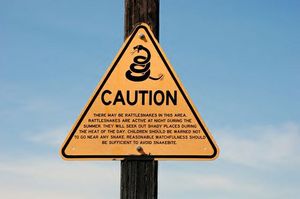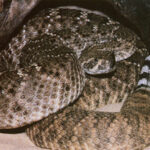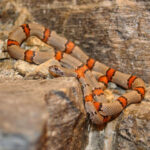North Carolina has plenty of outdoor fun during the spring and summer months, but with the fun comes snakes. However we only have 6 different breeds of poisonous snakes in North Carolina. I will list the ones that are poisonous and a little about each one. I will also provide tips for avoiding them, and what to do if you ARE bitten.
Copperhead
The Copperhead is probably the most common poisonous snake in North Carolina, thus the more likely to bite you. However the Copperhead’s venom is relatively mild and a human death from their bites are rare. They are called Copperheads due to the copper color of their heads. The body is usually tan colored but can have a pinkish tint. They have dark bands usually hour glass shaped on them. Baby Copperheads have a yellow tip on their tails. They will live just about anywhere in North Carolina. They like to be near streams but will be found in many different types of habitats.
Canebrake Rattlesnake
The Canebrake Rattlesnake is pinkish to tan in color. It has brown to black blotches on the body. It has a stripe down it’s back and one from the jaw to the eye. They like to live in forests and sometimes swampy areas and of course cane fields.
Eastern Diamondback Rattlesnake
This is the biggest poisonous snake found in North America, much less North Carolina. Some 8 feet long have been captured. They tend to feed on larger mammals than most snakes, such as squirrels. They like to live in pine forests and brushy fields near forests.
Cottonmouth
The Cottonmouth can and will kill you! It has a very venomous bite, though like most snakes it will flee if it can. They are usually brown in the body and are named from the white on the inside of the mouth. It has a visible stripe on the side of it’s head. If you are looking straight down at one, you can’t see it’s eyes, they don’t protrude. Many harmless water snakes are confused with the Cottonmouth. They swim with their head stuck out of the water. They are found in swamps, rivers, lakes and even ditches in Eastern North Carolina.
Pigmy Rattlesnake
These are very small rattlesnakes; the adults seldom grow over 18 inches. They are so small that their rattle can barely be heard. They are small but are scrappers, they will bite more quickly than most snakes. But they inject a very small amount of poison, and are seldom if ever deadly to humans. They like to live in longleaf pine or scrub oak forests.
All of the above snakes are pit vipers, named because of the pits on their heads, near the nostrils. They all have long hollow fangs that fold back in their mouths. They also have a triangular shaped head.
The Eastern Coral Snake
The only poisonous snake in North Carolina that is not a pit viper. They do not have the distinctive triangular shaped head of the other poisonous snakes in NC. They are related to cobras. They are very unlikely to bite unless bothered. They live in the sand hills of South Eastern North Carolina, and spend most of their time underground. There are many snakes that look similar to the Coral Snake. But the poisonous version always has red bands next to yellow ones. The old saying is “Red and Yellow, kill a fellow” These are highly toxic but very rarely found.
Avoiding Snakes
Around the home, cut the grass short and keep debris up out of the yard. Most snakes love to hide under piles of wood, or even bricks or brush that has been cut. They also will get under houses and in or under storage buildings. If a old building has rats, there is every change is has snakes!
While enjoying outdoor activities be aware of your surroundings. Know the types of poisonous snakes in your area, and know where they like to be. Watch carefully before taking a step on a trail. Also be aware of overhanging tree limbs that may have a snake on them. Avoid walking around at night in the woods, as a lot of snakes hunt at night.
If Bitten
According to The Carolina’s Poison Center, if you are bitten by a snake, this is what to do. If it’s a non poisonous snake, wash the bite area with warm soapy water, and possibly get a tetanus shot.
If you ARE bitten by a poisonous snake, stay calm first of all. Try to Identify the snake by coloring, markings and shape of the head. Make a note of what it looks like to tell the Emergency Room Doctors. It is not recommended that you kill the snake, as it may bite again when you try. (Authors note- if you DO kill it, bring it to the ER with you- but remember a dead snake can bite from reflex) Dial 911 or the Carolina’s Poison Control Center for advice before attempting first aid. Keep the victim in one position, flat on the back is best, keep the bitten limb at an even level with the rest of the body.
Do NOT try to suck the poison out or cut the wound, that does not really work. Do not use a tourniquet or pack the wound in ice.
There is a rumor that black snakes mate with copperheads and produce poisonous black snakes. I can find nothing supporting this, and it’s kind of dumb. So don’t go killing black snakes! They are good to have around; they kill rodents and compete for food with poisonous snakes. They are usually better hunters than copperheads, so a copperhead will leave an area with blacksnakes, so they can find prey easier.






